Welcome to the wonderful world of artisan baking! As someone who's spent countless hours perfecting the art of naturally leavened bread, I'm thrilled to share this incredible sourdough cinnamon raisin bread recipe with you. This isn't just any ordinary bread ; it's a masterpiece that combines the tangy complexity of sourdough with the sweet comfort of cinnamon and plump raisins, creating a loaf that will make your kitchen smell absolutely divine.
What makes this sourdough cinnamon raisin bread truly special is how the long fermentation process develops deep, complex flavors while keeping the bread naturally healthy and easily digestible. Whether you're a seasoned baker or just starting your sourdough journey, this recipe will guide you through creating a bakery-quality sourdough cinnamon raisin bread that's perfect for breakfast, afternoon tea, or any time you crave something wonderfully comforting.
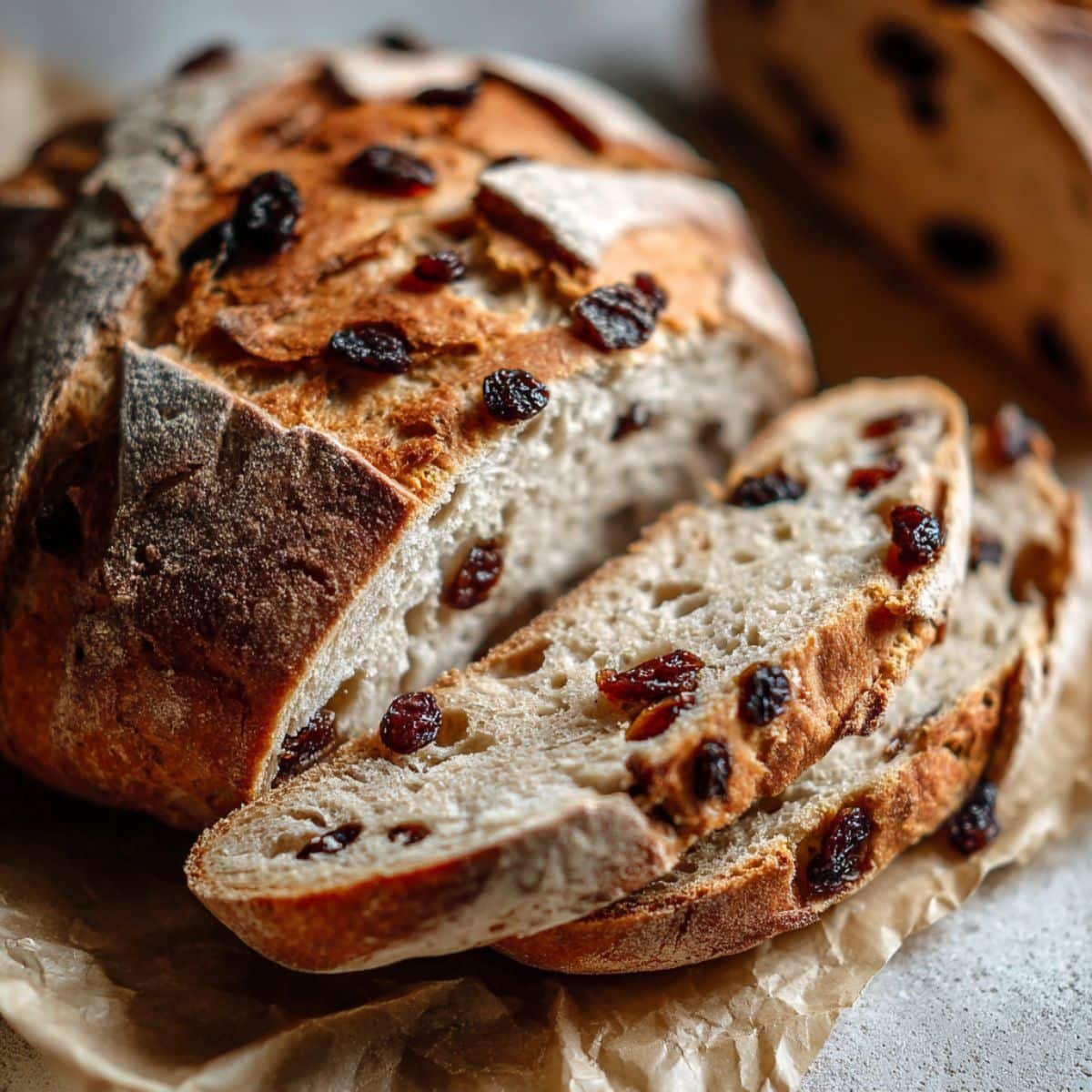
Background & Why This Recipe Stands Out
The magic of sourdough cinnamon raisin bread lies in its perfect balance of science and artistry. Unlike commercial yeasted breads that rush through the rising process, this naturally fermented approach allows the wild yeasts and beneficial bacteria in your starter to slowly transform simple ingredients into something extraordinary. The extended fermentation breaks down complex proteins and starches, making this sourdough cinnamon raisin bread not only more flavorful but also more nutritious and easier to digest.
What truly sets this recipe apart is the thoughtful timing of when we incorporate the cinnamon and raisins. By adding these flavor elements at just the right moment during the folding process, we ensure that every slice of your sourdough cinnamon raisin bread has the perfect distribution of spices and fruit without compromising the gluten development that gives us that coveted chewy texture. The result is a loaf that's tender yet structured, sweet yet complex, making it the ultimate expression of what homemade sourdough cinnamon raisin bread should be.
Jump to:
Ingredients
- Active sourdough starter
- Bread flour
- Whole wheat flour
- Warm water
- Sea salt
- Ground cinnamon
- Brown sugar
- Raisins
- Butter
- Honey
- Vanilla extract
- Egg wash
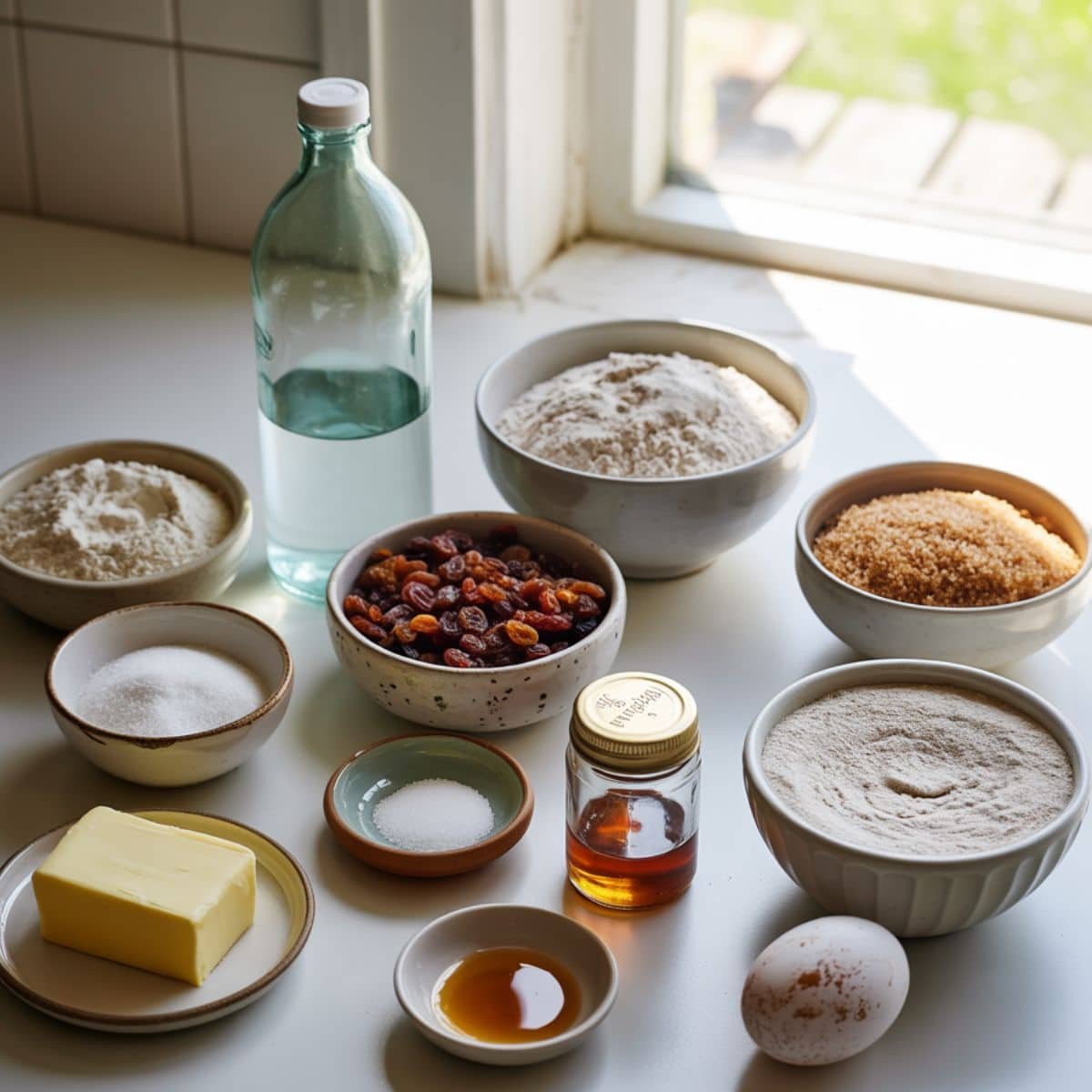
See recipe card for quantities.
Instructions
Prepare the Dough Foundation
- Mix active sourdough starter with warm water until completely dissolved
- Combine bread flour and whole wheat flour in a large mixing bowl
- Add the starter mixture to the flour and mix until a shaggy dough forms
- Cover and let rest for 30 minutes to allow flour hydration
Develop Structure and Add Flavors
- Dissolve sea salt in a small amount of water and work into the dough
- Perform four sets of stretch and folds every 30 minutes
- During the third fold, incorporate pre-soaked raisins and cinnamon mixture
- Continue bulk fermentation until dough increases by 50-70%
Shape, Final Rise, and Bake
- Pre-shape the dough into a loose round and rest for 20 minutes
- Shape into final loaf form and place in banneton or bowl
- Cold ferment in refrigerator for 8-24 hours for optimal flavor development
- Score the dough and bake in preheated Dutch oven at 450°F
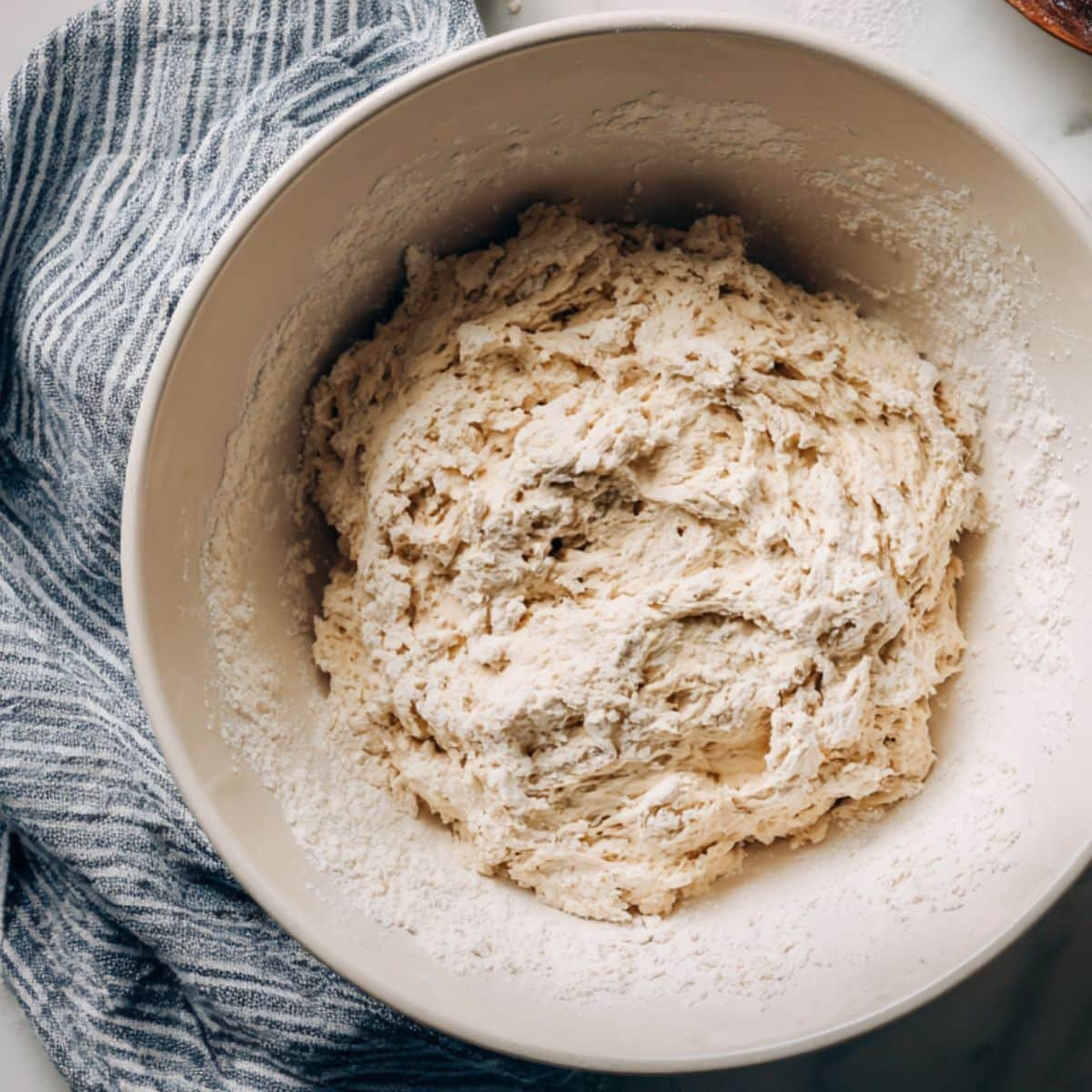
- Prepare the Dough Foundation: Starter, flour, and water mixed into shaggy dough in bowl
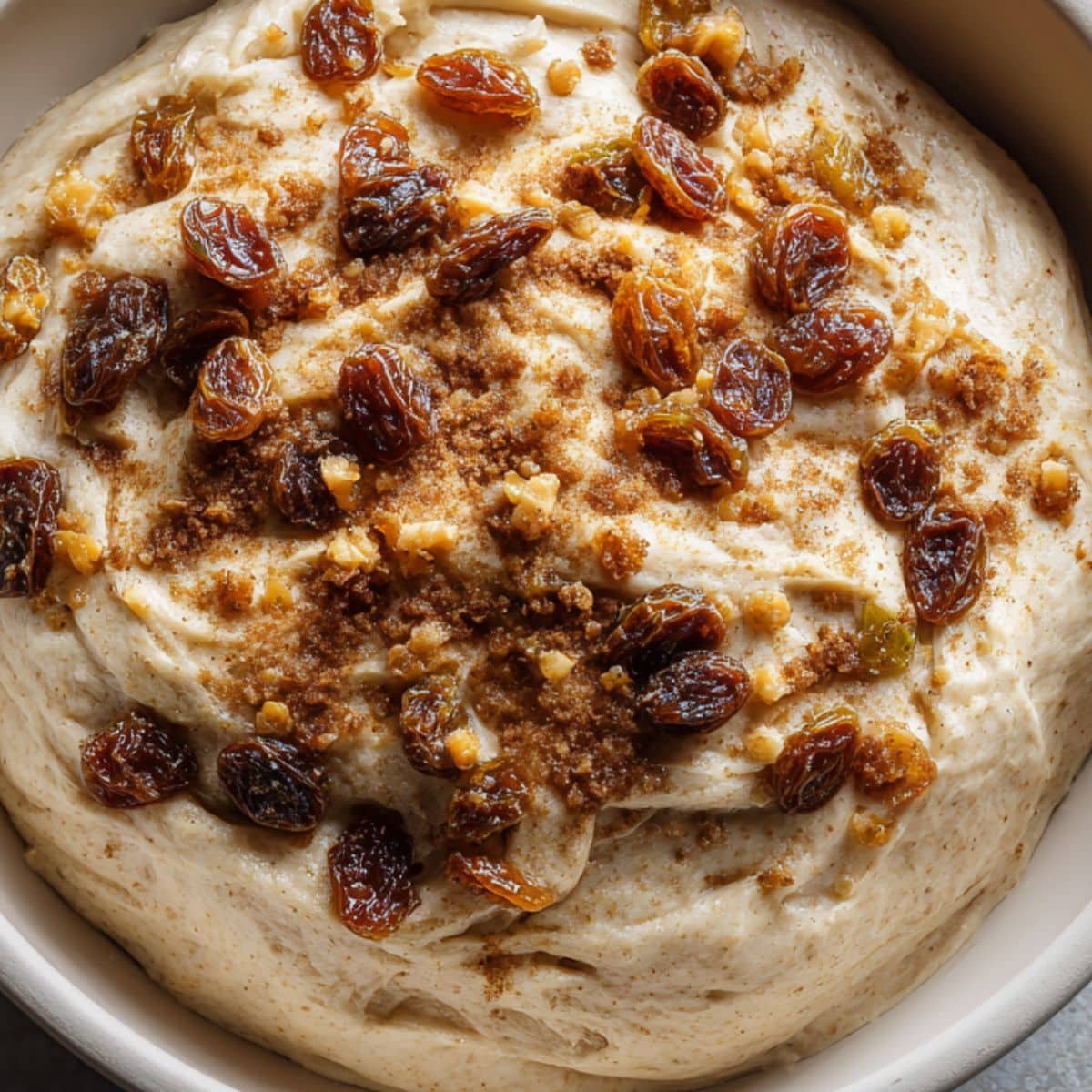
- Develop Structure and Add Flavors: stretching dough with raisins & cinnamon being folded in
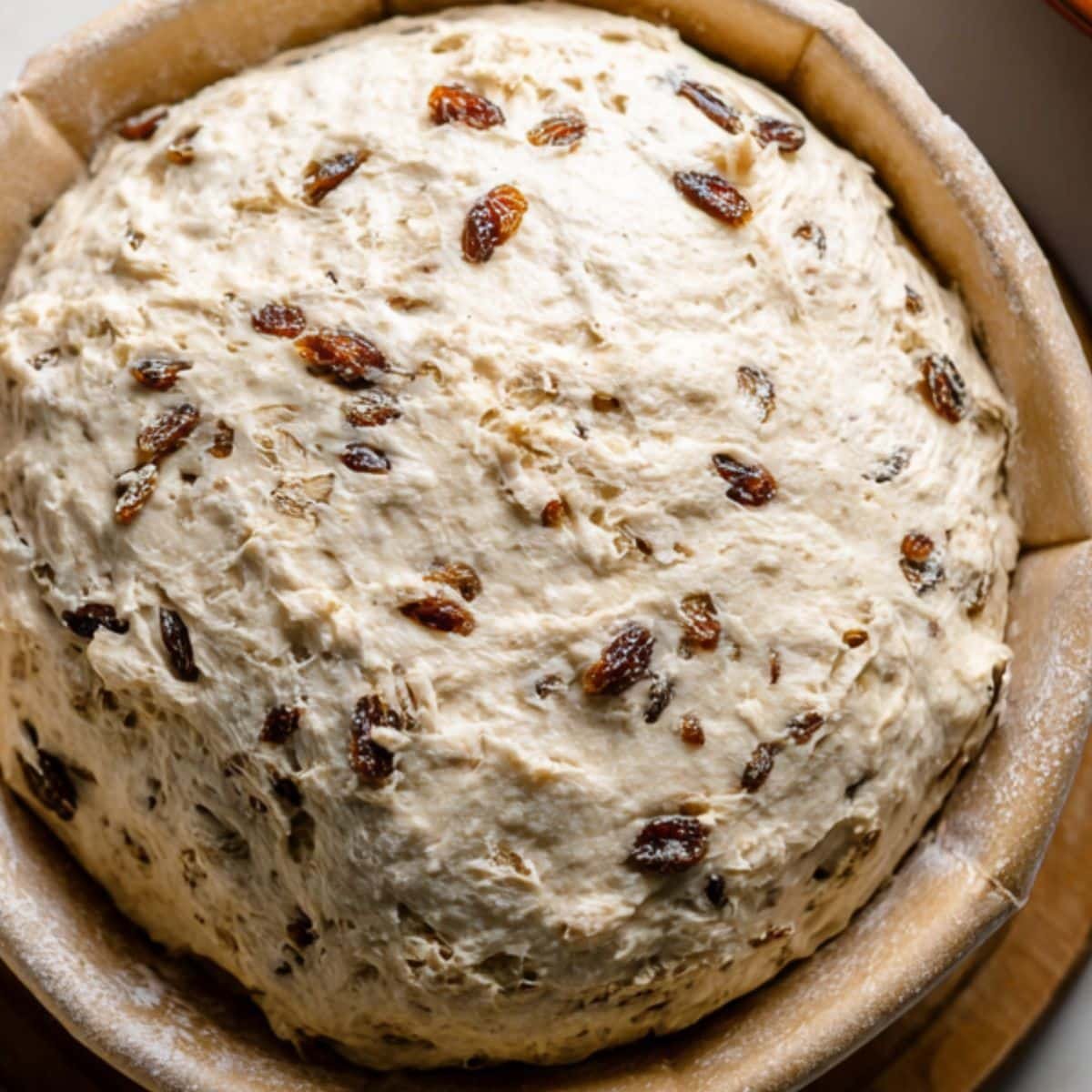
- Shape, Final Rise, and Bake: Dough shaped in banneton and baked in Dutch oven
Equipment For Sourdough Cinnamon Raisin Bread
- Large mixing bowl
- Kitchen scale for accurate measurements
- Bench scraper for handling dough
- Banneton or proofing basket
- Dutch oven with lid
- Sharp knife or lame for scoring
- Clean kitchen towels
- Instant-read thermometer
Expert Cooking Tips
- Use a mature, active starter that doubles in size within 4-6 hours
- Soak raisins in warm water for 10 minutes before adding to prevent moisture loss
- Maintain dough temperature between 75-78°F for optimal fermentation
- Don't skip the cold retard ; it dramatically improves flavor development
- Score decisively and quickly to achieve beautiful oven spring
- Internal temperature should reach 205-210°F when fully baked
- Cool completely before slicing to prevent gummy texture
Recipe Variations
- Substitute dried cranberries or chopped dates for raisins
- Add chopped walnuts or pecans for extra texture and nutrition
- Create a chocolate version by adding cocoa powder and chocolate chips
- Make it holiday-special with orange zest and cardamom
- Try a savory twist with rosemary and sun-dried tomatoes
- Use maple syrup instead of honey for different sweetness notes
- Experiment with different flour ratios for varied textures
Storage
- Cool bread completely before storing to prevent condensation
- Wrap in clean kitchen towel and store at room temperature for 3-4 days
- Freeze sliced portions in airtight containers for up to 3 months
- Refresh day-old bread by lightly toasting or warming in oven
- Store in paper bag rather than plastic to maintain crust texture
- Keep away from direct sunlight and heat sources
The Secret Behind Irresistible Sourdough Magic
The true secret to exceptional sourdough cinnamon raisin bread lies in understanding the delicate dance between time and temperature. Many bakers rush the process, but patience is your greatest ally here. The extended cold fermentation not only develops those complex, tangy notes that make sourdough so addictive, but it also allows the cinnamon to meld beautifully with the dough, creating layers of flavor that unfold with each bite.
Another closely guarded secret is the technique of "laminating" your cinnamon sugar mixture into the dough during shaping. Instead of simply mixing everything together, we create distinct layers that spiral through the loaf, giving you those gorgeous cinnamon swirls that make each slice a work of art. This method ensures that your sourdough cinnamon raisin bread has visual appeal and flavor distribution that rivals any artisan bakery.
FAQ
Does cinnamon affect sourdough rising?
Cinnamon contains compounds that can slightly inhibit yeast activity, but when used in moderate amounts in sourdough cinnamon raisin bread, the effect is minimal. The wild yeasts in sourdough are generally more robust than commercial yeast, so your bread will still rise beautifully. To minimize any potential impact, add cinnamon during the fold stage rather than mixing it in initially, allowing your starter to establish its fermentation rhythm first.
When to add cinnamon and raisins to sourdough bread?
The optimal time to incorporate cinnamon and raisins into your sourdough cinnamon raisin bread is during the third set of stretch and folds, typically 90 minutes into bulk fermentation. This timing allows the gluten structure to develop properly while ensuring even distribution of flavors. Adding them too early can interfere with gluten development, while adding too late makes it difficult to achieve uniform incorporation throughout the loaf.
Why is sourdough bread not fattening?
Sourdough cinnamon raisin bread is naturally more nutritious than commercial breads due to the fermentation process. The beneficial bacteria pre-digest complex carbohydrates and proteins, making nutrients more bioavailable and easier to digest. The natural acids produced during fermentation also help regulate blood sugar spikes, while the fiber content promotes satiety. Additionally, the slow fermentation process reduces the glycemic index compared to quick-rise breads.
Can you put cinnamon in sourdough bread?
Absolutely! Cinnamon is a wonderful addition to sourdough cinnamon raisin bread and pairs beautifully with the tangy notes of natural fermentation. The key is using high-quality ground cinnamon and incorporating it at the right stage of the process. Ceylon cinnamon is preferred over cassia for its delicate, sweet flavor that complements rather than overwhelms the sourdough character. Start with modest amounts and adjust to your taste preferences.
Expand Your Baking Horizons
Now that you've mastered this incredible sourdough cinnamon raisin bread, it's time to explore other delicious baking adventures! The techniques you've learned here ; patience, proper fermentation, and attention to detail ; will serve you well in all your future baking endeavors. Your newfound confidence with wild yeast and natural fermentation opens up a whole world of artisan bread possibilities.
Consider trying our Simple Pumpkin Banana Bread Recipe for a quick weekend treat that requires no starter maintenance, or challenge yourself with our Perfect Cheesecake Factory Brown Bread Recipe that brings restaurant-quality results to your home kitchen. Both recipes complement the skills you've developed making sourdough cinnamon raisin bread while offering exciting new flavors and techniques to master. Happy baking!
From my kitchen, with heart.
Nicole Harper ❤️
Related
Looking for other recipes like this? Try these:
Pairing
These are my favorite dishes to serve with Sourdough Cinnamon Raisin Bread

Sourdough Cinnamon Raisin Bread
Equipment
- 1 Large mixing bowl For dough mixing
- 1 Kitchen scale Accuracy is essential
- 1 Bench scraper Helps handle sticky dough
- 1 Banneton/proofing basket For final rise
- 1 Dutch oven with lid Ensures steam & oven spring
- 1 Sharp knife or lame Scoring the dough
- 2 Kitchen towels Covering dough during rest
- 1 Instant-Read Thermometer Check internal bake temp
Ingredients
Main Dough
- 150 g Active sourdough starter Mature and bubbly
- 400 g Bread flour Strong gluten structure
- 100 g Whole wheat flour Adds flavor & nutrition
- 350 g Warm water Around 75–78°F
- 10 g Sea salt Dissolved in water before adding
Filling and Flavor
- 2 teaspoon Ground cinnamon Preferably Ceylon
- 2 tablespoon Brown sugar For sweetness
- 150 g Raisins Pre-soaked 10 min in warm water
- 20 g Butter Softened, optional richness
- 1 tablespoon Honey Natural sweetness
- 1 teaspoon Vanilla extract Flavor depth
- 1 Egg wash For golden crust
Instructions
- Mix starter with water, then add flours until shaggy dough forms; rest 30 min.
- Add salt water; perform stretch & folds every 30 min.
- During 3rd fold, add raisins, cinnamon, and sugar.
- Bulk ferment until 50–70% rise.
- Pre-shape, rest 20 min, then final shape.
- Cold retard 8–24 hours in the fridge.
- Score loaf and bake at 450°F in Dutch oven until internal temp reaches 205–210°F.
- Cool completely before slicing.









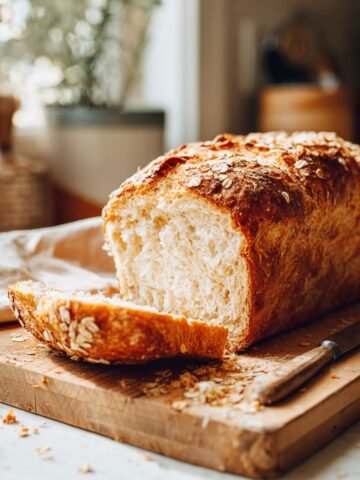

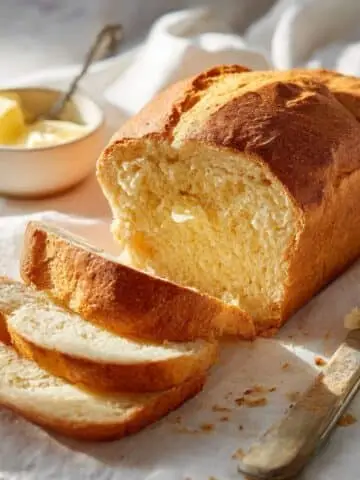

Leave a Reply